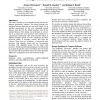Free Online Productivity Tools
i2Speak
i2Symbol
i2OCR
iTex2Img
iWeb2Print
iWeb2Shot
i2Type
iPdf2Split
iPdf2Merge
i2Bopomofo
i2Arabic
i2Style
i2Image
i2PDF
iLatex2Rtf
Sci2ools
CHI
2002
ACM
2002
ACM
An evaluation of a multiple interface design solution for bloated software
This study examines a novel interface design for heavilyfeatured productivity software. The design includes two interfaces between which the user can easily toggle: (1) an interface personalized by the user containing desired features only, and (2) the default interface with all the standard features. This design was prototyped as a frontend to a commercial word processor and evaluated in a comprehensive field study. The study tested the effects of different interface designs on users' satisfaction and their perceived ability to navigate, control, and learn the software. There were two conditions: a commercial word processor with adaptive menus and our two-interface prototype with adaptable menus for the same word processor. Results showed that participants were better able to navigate through the menus and toolbars and were better able to learn with our prototype. There were also significant differences in satisfaction and control with our design. Keywords Featurism, bloat, pers...
CHI 2002 | Commercial Word Processor | Comprehensive Field Study | Default Interface | Human Computer Interaction |
| Added | 01 Dec 2009 |
| Updated | 01 Dec 2009 |
| Type | Conference |
| Year | 2002 |
| Where | CHI |
| Authors | Joanna McGrenere, Ronald Baecker, Kellogg S. Booth |
Comments (0)

